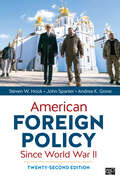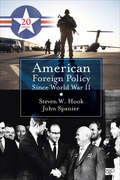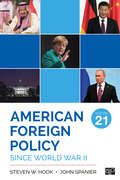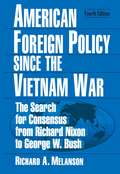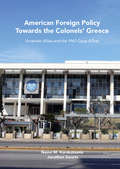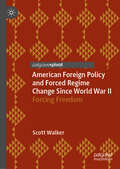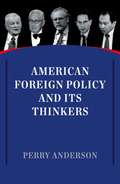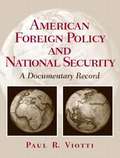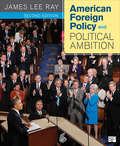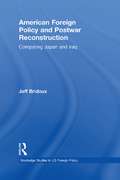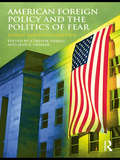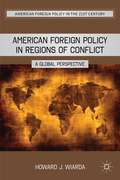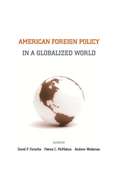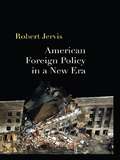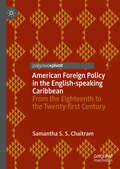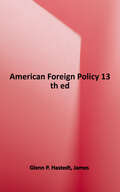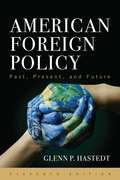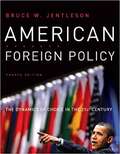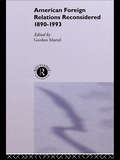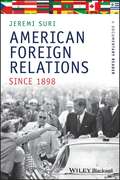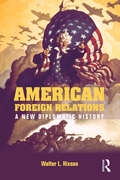- Table View
- List View
American Foreign Policy Since World War II
by Steven W. Hook John W. Spanier Andrea K. GroveNow in its Twenty-Second Edition, Hook, Spanier, and Grove’s American Foreign Policy Since World War II has long set the standard in guiding students through the complexities of American foreign policy. The text introduces students to the American "style" of foreign policy, imbued with a distinct sense of national exceptionalism. By giving students the historical context they need, this book allows them to truly grasp the functions and dysfunctions of the nation’s foreign policy agenda with historical insight into modern policy context.
American Foreign Policy Since World War II
by Steven W. Hook John W. SpanierSteven Hook and John Spanier’s classic text, American Foreign Policy Since World War II, celebrates its Twentieth Edition. It has remained the standard for guiding students through the complexities of American foreign policy by showing how recent developments confirm the book’s overarching theme—that there is an American “style” of foreign policy imbued with a distinct sense of national exceptionalism. Giving students important historical context, the book allows them to grasp the functions and frequent dysfunctions of the nation’s evolving foreign policy agenda. In this new edition, chapters covering the end of the Cold War have been combined and streamlined, making room for a new chapter that examines the aftershocks of the Arab Spring, political breakdowns in Iraq and Afghanistan, and the rise of the Islamic State. The final chapter considers the revival of power politics in world politics, with Russia and China stepping up their attempts to weaken the United States and create a multipolar world. The book ends by reconsidering America’s distinctive style of foreign policy and its resilience amid such turbulence since World War II.
American Foreign Policy Since World War II
by Steven W. Hook John W. SpanierSteven Hook and John Spanier’s classic text, American Foreign Policy Since World War II, celebrates its Twentieth Edition. It has remained the standard for guiding students through the complexities of American foreign policy by showing how recent developments confirm the book’s overarching theme—that there is an American “style” of foreign policy imbued with a distinct sense of national exceptionalism. Giving students important historical context, the book allows them to grasp the functions and frequent dysfunctions of the nation’s evolving foreign policy agenda. In this new edition, chapters covering the end of the Cold War have been combined and streamlined, making room for a new chapter that examines the aftershocks of the Arab Spring, political breakdowns in Iraq and Afghanistan, and the rise of the Islamic State. The final chapter considers the revival of power politics in world politics, with Russia and China stepping up their attempts to weaken the United States and create a multipolar world. The book ends by reconsidering America’s distinctive style of foreign policy and its resilience amid such turbulence since World War II.
American Foreign Policy Since World War II
by Steven W. Hook John W. SpanierThe Gold Standard for Textbooks on American Foreign Policy American Foreign Policy Since World War II provides you with an understanding of America’s current challenges by exploring its historical experience as the world’s predominant power since World War II. Through this process of historical reflection and insight, you become better equipped to place the current problems of the nation’s foreign policy agenda into modern policy context. With each new edition, authors Steven W. Hook and John Spanier find that new developments in foreign policy conform to their overarching theme—there is an American “style” of foreign policy imbued with a distinct sense of national exceptionalism. This Twenty-First Edition continues to explore America’s unique national style with chapters that address the aftershocks of the Arab Spring and the revival of power politics. Additionally, an entirely new chapter devoted to the current administration discusses the implications of a changing American policy under the Trump presidency.
American Foreign Policy Since World War II
by Steven W. Hook John W. SpanierThe Gold Standard for Textbooks on American Foreign Policy American Foreign Policy Since World War II provides you with an understanding of America’s current challenges by exploring its historical experience as the world’s predominant power since World War II. Through this process of historical reflection and insight, you become better equipped to place the current problems of the nation’s foreign policy agenda into modern policy context. With each new edition, authors Steven W. Hook and John Spanier find that new developments in foreign policy conform to their overarching theme—there is an American “style” of foreign policy imbued with a distinct sense of national exceptionalism. This Twenty-First Edition continues to explore America’s unique national style with chapters that address the aftershocks of the Arab Spring and the revival of power politics. Additionally, an entirely new chapter devoted to the current administration discusses the implications of a changing American policy under the Trump presidency.
American Foreign Policy Since World War II (17th Edition)
by Steven W. Hook John SpanierThe United States remains engaged in an open-ended "war on terrorism" with no foreseeable endpoint.
American Foreign Policy Since the Vietnam War: The Search for Consensus from Nixon to Clinton
by Richard A MelansonThis book integrates the study of presidential politics and foreign policy-making from the Vietnam aftermath to the events following September 11 and the Iraqi War. Focusing on the relationship between presidents' foreign policy agendas and domestic politics, it offers compelling portraits of presidents Nixon, Carter, Reagan, Bush I, Clinton, and Bush II. In the course of comparing the efforts of these presidents to articulate a clear conception of the national interest and to forge a foreign policy consensus, the author shows the key role of public opinion in constraining presidential initiatives, in particular the decision to use military force overseas. Never more timely, this popular text is appropriate for courses in U.S. foreign policy, the presidency, or contemporary U.S. politics.
American Foreign Policy Towards the Colonels' Greece: Uncertain Allies And The 1967 Coup D'état
by Jonathan Swarts Neovi M. KarakatsanisThis book seeks to comprehensively analyze and document U.S. foreign policy toward a strategic Cold War ally that posed a stark challenge to the traditionally-stated U.S. preference for democracy and political freedom. It details the complex ways in which the U.S. reacted to that challenge and went about crafting policies of longer-term accommodation with a regime it wished to retain as a close ally in a strategically important part of the world.
American Foreign Policy and Forced Regime Change Since World War II: Forcing Freedom
by Scott WalkerThis book explores the motivations behind American military interventions in the Post-World War II era that purported to replace autocratic regimes with democratic ones. It delves into the Forced Democracy (FD) phenomenon, focusing on its intellectual roots and previous attempts to study it in the academic literature. The author examines five American interventions that attempted to replace autocratic regimes with democratic ones—The Dominican Republic, Grenada, Panama, Afghanistan, and Iraq. Each chapter includes a history of the intervention and an assessment of whether America’s intentions and actions toward that particular country were actually focused on delivering a democratic outcome.
American Foreign Policy and Its Thinkers
by Perry AndersonMagisterial account of the ideas and the figures who have forged the American Empire.Since the birth of the nation, impulses of empire have been close to the heart of the United States. How these urges interact with the way the country understands itself, and the nature of the divergent interests at work in the unfolding of American foreign policy, is a subject much debated and still obscure. In a fresh look at the topic, Anderson charts the intertwined historical development of America's imperial reach and its role as the general guarantor of capital.The internal tensions that have arisen are traced from the closing stages of the Second World War through the Cold War to the War on Terror. Despite the defeat and elimination of the USSR, the planetary structures for warfare and surveillance have not been retracted but extended. Anderson ends with a survey of the repertoire of US grand strategy, as its leading thinkers--Brzezinski, Mead, Kagan, Fukuyama, Mandelbaum, Ikenberry, Art and others--grapple with the tasks and predicaments of the American imperium today.From the Hardcover edition.
American Foreign Policy and National Security: A Documentary Record
by Paul R. ViottiThis annotated and edited anthology brings together the documents most closely related to the making of American foreign and national security policy. It focuses on the Constitutional context; the organizational context; strategy, doctrine, and policy; arms control and disarmament; and multilateralism in terms of security, economy, and identity. The U. S. Constitution, Foreign Policy and National Security. Legislative-Executive Authority. The Constitutional Allocation of War Powers. Foreign Policy and National Security in the Executive Branch. Before World War II. World War II. The Cold War. Nuclear Weapons, Deterrence and Foreign Policy. Controlling Armaments. Spatial Limits: Geographic or Locational Approaches to Arms Control. Functional Approaches to Conflict and Arms Control. Global Organizations. Collective Security and Collective Defense. The Environment and the Economy. Human Rights. For anyone interested in American Foreign Policy, Defense Policy, Foreign Policy Making.
American Foreign Policy and Political Ambition
by James L. RayIn his eagerly-awaited second edition of American Foreign Policy and Political Ambition, James Ray revisits his deceptively simple premise that the highest priority of leaders is to stay in power. Looking at how political ambition and domestic pressures impact foreign policymaking is the key to understanding how and why foreign policy decisions are made. The text begins by using this analytic approach to look at the history of foreign policymaking and then examines how various parties inside and outside government influence decision making. In a unique third section, the book takes a regional approach, not only covering trends other books tend to miss, but giving students the opportunity to think comprehensively about how issues intersect around the globe—from human security and democratization, to globalization and pollution. Guided by input from adopters and reviewers, Ray has thoroughly re-organized the book and streamlined some coverage to better consolidate the historical, institutional, regional, and topical chapters and focus the thematic lens of the book. Ray has also brought the book fully up-to-date, addressing the latest events in American foreign policy, including the wars in Afghanistan and Iraq, the killing of Bin Laden, the WikiLeaks scandal and its aftermath, the impact of social media on foreign policy and world affairs, nuclear proliferation, developments in U.S.-Russian relations, climate change, and more.
American Foreign Policy and Postwar Reconstruction: Comparing Japan and Iraq (Routledge Studies in US Foreign Policy)
by Jeff BridouxOn the eve of the invasion of Iraq, President G.W. Bush argued that if setting up democracy in Japan and Germany after WW II was successful, then it should also be successful in Iraq. This book provides a detailed comparison of the reconstruction of Japan from 1945 to 1952 with the current reconstruction of Iraq, evaluating the key factors affecting the success or failure of such projects. The book seeks to understand why American officials believed that extensive social reengineering aiming at seeding democracy and economic development is replicable, through identifying factors explaining the outcome of U.S.-led post-conflict reconstruction projects. The analysis reveals that in addition to the effective use of material resources of power, the outcome of reconstruction projects depends on a variety of other intertwined factors, and Bridoux provides a new analytical framework relying on a Gramscian concept of power to develop a greater understanding of these factors, and the ultimate success or failure of these reconstruction projects. Appraising the effectiveness of American power in the contemporary international structure, this work is a significant contribution to the field and will be of great interest to all scholars of foreign policy, international relations and conflict studies.
American Foreign Policy and The Politics of Fear: Threat Inflation since 9/11 (Routledge Global Security Studies)
by A. Trevor Thrall Jane K. CramerThis edited volume addresses the issue of threat inflation in American foreign policy and domestic politics. The Bush administration's aggressive campaign to build public support for an invasion of Iraq reheated fears about the president's ability to manipulate the public, and many charged the administration with 'threat inflation', duping the news media and misleading the public into supporting the war under false pretences. Presenting the latest research, these essays seek to answer the question of why threat inflation occurs and when it will be successful. Simply defined, it is the effort by elites to create concern for a threat that goes beyond the scope and urgency that disinterested analysis would justify. More broadly, the process concerns how elites view threats, the political uses of threat inflation, the politics of threat framing among competing elites, and how the public interprets and perceives threats via the news media. The war with Iraq gets special attention in this volume, along with the 'War on Terror'. Although many believe that the Bush administration successfully inflated the Iraq threat, there is not a neat consensus about why this was successful. Through both theoretical contributions and case studies, this book showcases the four major explanations of threat inflation -- realism, domestic politics, psychology, and constructivism -- and makes them confront one another directly. The result is a richer appreciation of this important dynamic in US politics and foreign policy, present and future. This book will be of much interests to students of US foreign and national security policy, international security, strategic studies and IR in general. Trevor Thrall is Assistant Professor of Political Science and directs the Master of Public Policy program at the University of Michigan - Dearborn. Jane Kellett Cramer is an Assistant Professor of Political Science at the University of Oregon.
American Foreign Policy in Regions of Conflict
by Howard J. WiardaAmerica's regional foreign policy priorities are shifting, toward Asia, the Middle East, Latin America, and Africa, and away from Europe and Russia. Wiarda examines these changes and the reasons for them in each of these regional areas in this comprehensive work on global perspective on American foreign policy. Designed as a text for introductory international relations, foreign policy, comparative politics, and world politics courses, this book succeeds in integrating these often separate subfields and shows how the study of comparative politics can enlighten foreign policy.
American Foreign Policy in a Globalized World
by David P. Forsythe Andrew Wedeman Patrice C. MacMahonIn this volume, several leading foreign policy and international relations experts consider the long term prospects and implications of US foreign policy as it has been shaped and practiced during the presidency of George W. Bush. The essays in this collection - based on the research of well-respected scholars such as Ole Holsti, Loch Johnson, John Ruggie, Jack Donnelly, Robert Leiber, Karen Mingst, and Edward Luck - offer a clear assessment: while US resources are substantial, Washington's ability to shape outcomes in the world is challenged by its expansive foreign policy goals, its exceptionalist approach to international relations, serious questions about the limits of its hard power resources as well as fundamental changes in the global system. Illustrating one of the central ironies of the contemporary situation in foreign affairs and international relations: that at the very time of the ‘unipolar moment,’ the world has become globalized to such an extent that the unilateralism of the Bush Administration leads as much to resistance as it does to coercion, compliance, and cooperation. American Foreign Policy in a Globalized World will be of interest to students and scholars of politics and international relations.
American Foreign Policy in a New Era
by Robert JervisTo say that the world changed drastically on 9/11 has become a truism and even a cliché. But the incontestable fact is that a new era for both the world and US foreign policy began on that infamous day and the ramifications for international politics have been monumental.In this book, one of the leading thinkers in international relations, Robert Jervis, provides us with several snapshots of world politics over the past few years. Jervis brings his acute analysis of international politics to bear on several recent developments that have transformed international politics and American foreign policy including the War on Terrorism; the Bush Doctrine and its policies of preventive war and unilateral action; and the promotion of democracy in the Middle East (including the Iraq War) and around the world. Taken together, Jervis argues, these policies constitute a blueprint for American hegemony, if not American empire. All of these events and policies have taken place against a backdrop equally important, but less frequently discussed: the fact that most developed nations, states that have been bitter rivals, now constitute a "security community" within which war is unthinkable.American Foreign Policy in a New Era is a must read for anyone interested in understanding the policies and events that have shaped and are shaping US foreign policy in a rapidly changing and still very dangerous world.
American Foreign Policy in the English-speaking Caribbean: From the Eighteenth to the Twenty-first Century
by Samantha S. ChaitramThis book traces American engagement in the English-speaking Caribbean from the eighteenth to the twenty-first century, and is the first to examine the policies of Presidents George W. Bush, Barack Obama and Donald Trump in this context. Focusing on The Bahamas, Jamaica, Trinidad and Tobago and Guyana as case studies, the book describes the growth of the English-speaking Caribbean and highlights American interest and foreign relations in this region from European discovery up through the post-9/11 era to today (1492-2019). The book demonstrates the unique relationship between America and the former British colonies, shedding light on U.S. foreign policy with the Caribbean in general and at a bilateral level with the four selected countries, providing a useful survey for students, scholars, diplomats, policymakers, governments officials, and anyone interested in gaining a better understanding of U.S. – Caribbean relations.
American Foreign Policy: Past, Present, and Future
by Glenn P. HastedtWorld affairs are constantly in flux, so students need to be prepared not just to know what’s happening in the headlines but how to make sense of those events. Hastedt’s American Foreign Policy helps students develop the critical thinking skills needed to participate in debates about foreign relations―today and throughout their lives. Rather than focus on normative questions about what direction the country should take on the world stage, this text is designed to provide the historical and institutional context for the foreign policy process, from the governmental and civil society actors involved to the issues that comprise the conduct and content of American foreign policy. <p><p>This thirteenth edition comes at a time when Biden’s presidency is facing some of the most important foreign policy questions in a generation, from the U.S. withdrawal from Afghanistan to what we should do about the Russian invasion of Ukraine. These issues have emerged as many of the traditional foundations in American foreign policy have been disrupted during the Trump administration, pleasing some and angering others but almost uniformly raising political tensions at home and abroad. The revision includes up-to-date coverage of the war in Ukraine, the U.S. exit from Afghanistan, health diplomacy and the response to COVID, the resurgence of great power politics, and other features of the Biden administration’s foreign policy.
American Foreign Policy: Past, Present, and Future (Eleventh Edition)
by Glenn P. HastedtGlenn Hastedt’s clear and succinct introduction to the field prepares students to think about America’s changing role in the world and to develop the critical thinking skills needed to participate in the debate about the conduct and content of American foreign policy. He begins by asking “What do we mean by foreign policy and what is the national interest?” Next, Hastedt looks to the past and examines the defining experiences that have helped to shape American foreign policy today. Third, he looks at how American foreign policy is made in the current hyperpartisan political climate. Here Hastedt examines the various institutions and how they come together to make policy, as well as the policy instruments available to decision makers. And finally, he encourages students to wonder, “What’s next?” <p><p> The eleventh edition reflects the latest headlines, including more extensive discussions of hybrid warfare, cyber wars, drones, and an assessment of Obama’s foreign policy. There are new case studies on ISIS, authorization of force resolutions, women in combat, the climate agreement, the Iran nuclear agreement, Obama’s opening to Cuba, and the future of COIN. And new Historical Lessons boxes feature the War Powers Act, the integration of the military, the Kyoto Agreement, NAFTA, and Afghanistan.
American Foreign Policy: The Dynamics Of Choice In The 21st Century
by Bruce W. JentlesonA crystal-clear, engaging introduction to U.S. foreign policy by one of the leading scholars in the field. Addressing both foreign policy strategy and foreign policy politics, Bruce Jentleson―respected scholar, award-winning teacher, and foreign policy practitioner―offers students the theoretical framework, historical context, and policy analysis essential for understanding American foreign policy in the twenty-first century. Professor Jentleson focuses on foreign policy strategy and foreign policy politics and employs a four-part framework (the four Ps: Power, Peace, Prosperity, and Principles) through which students can begin to appreciate the problems and choices faced by the United States as it tries to steer a course through world events. The Fourth Edition of American Foreign Policy has been thoroughly updated with relevant political developments, including foreign policy changes instituted by the Obama administration.
American Foreign Relations Reconsidered: 1890-1993
by Gordon MartelThis major new textbook brings together twelve of the leading scholars of U.S. foreign relations. Each contributor provides a clear, concise summary of an important period or theme in US diplomatic and strategic affairs since the Spanish-American War. Michael Hunt and Joan Hoff provide an overview of the traditions behind US policy and a preview of things to come. Together, the contributors offer a succinct explanation of the controversies and questions that historians have grappled with throughout the twentieth century. Students will find these essays a reliable and useful guide to the various schools of thought which have emerged. Although each of the scholars is well known for their detailed and original work, these essays are new and have been specially commissioned for this book. The articles follow the chronological development of the emergence of the United States as a world power, but special themes such as the American policy process, economic interests, relations with the Third World, and the dynamics of the nuclear arms race have been singled out for separate treatment. American Foreign Relations Reconsidered, 1890-1993 represents essential reading for upper level undergraduates studying modern American history. The book has been designed and written exclusively to meet the needs of students, either as a major course text, or as a set of supplementary readings to support other texts.
American Foreign Relations Since 1898 (Uncovering The Past: Documentary Readers In American History)
by Jeremi SuriThis volume brings together more than 50 documents which examine foreign policy not only in terms of leaders and states, but also through social movements, cultures, ideas, and images, to provide comprehensive understanding of how Americans have interacted with the wider world since 1898. <p><p> Draws together over 50 primary documents to give readers a first-hand account of the people and events that shaped the foreign policy of the United States <p> Incorporates documents relating not only to leaders and states, but also to social movements, cultures, ideas, and images <p> Highlights the diverse range of contributors to debates about American foreign policy, from presidents to protesters, students to singers <p> Includes a comprehensive introduction to the subject and headnotes for each document written by the editor, as well as a bibliography for further study
American Foreign Relations: A New Diplomatic History
by Walter L. HixsonAmerican Foreign Relations: A New Diplomatic History is a compelling narrative history of American foreign policy from the early settlement of North America to the present. In addition to economic and strategic motives, Walter L. Hixson integrates key cultural factors--including race, gender, and religion--into the story of American foreign policy. He demonstrates how these factors played a vital role in shaping the actions of the United States in world affairs. Beginning with the history of warfare and diplomacy between indigenous peoples and Europeans before the establishment of the United States, this book shows the formative influence of settler colonialism on the country's later foreign policy and the growth of American empire. Clearly written and comprehensive, the book features: Extensive illustrations, with over 100 images and maps Primary documents in each chapter, showcasing the perspectives of historical actors "Interpreting the Past" features that explore how historians' understanding of events has changed over time Selected bibliographies of key resources for further research in each chapter In one concise volume, American Foreign Relations covers the full sweep of American foreign policy from the colonial period to the present day. It is an essential introduction for anyone seeking to understand the history of America's role in the world.
